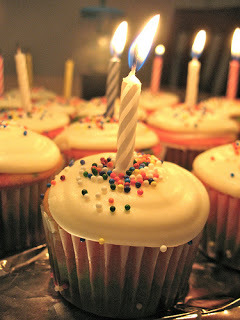Rebecca S. Ramsey's Blog, page 7
July 12, 2021
The Parable of the Mustard Seed
Welcome to the Parable of the Mustard Seed, found in Matthew 13:31-32, Mark 4:30-32, and Luke 13:18-19.
 The children love this parable, and if you help them process it through the wondering questions, they’re sure to come up with some profound thoughts and ideas.
The children love this parable, and if you help them process it through the wondering questions, they’re sure to come up with some profound thoughts and ideas.The wondering questions are in the book. I’ll have them printed out for you. Thank you for documenting the children’s responses. They’re so interesting for the parents-and for the rest of us!
Now, for some ideas to spark their imaginations as they do their work, making a gift to God…
1. How big do they imagine the mustard seed growing? Why not lay out butcher paper on the floor and let the children draw the tree? I’ve seen a class of fours do this, so I know all of ours can do it to. One team of kids could draw and fill in the tree, another do the leaves, another do the birds and birds’ nests, and another do the sower.
Our fourth grade class did this once and it turned out great!
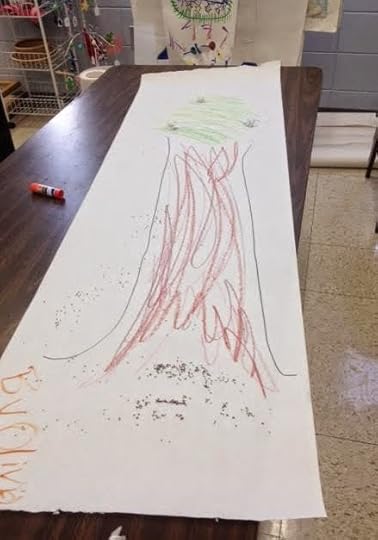
2. Children could individually glue a seed to a paper and draw what the tree will grow to be.
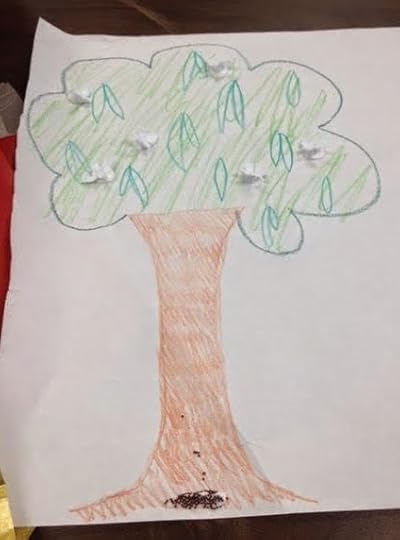
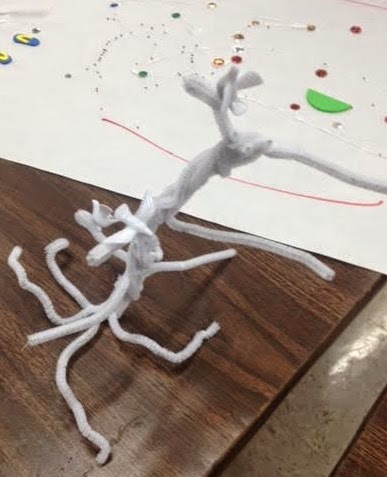 3. Kids could make a mustard tree out of pipe cleaners. They could even add birds!
3. Kids could make a mustard tree out of pipe cleaners. They could even add birds!
5. The kids could make their own parable box for this one. There’s felt in the resource room for the different parts, and they could also make a person out of a clothespin, birds and nests out of clay.
6. Make a mustard seed necklace as shown here
7. Sample different kids of mustard with pretzels or crackers as a snack.
Check out my Pinterest page here for more ideas.
Enjoy!
Love, Becky
The post The Parable of the Mustard Seed appeared first on beckyramsey.info.
July 7, 2021
The Parable of the Leaven
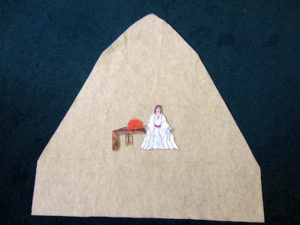 Welcome to the Parable of the Leaven, found in Matthew 13:33 and Luke 13:20-21.
Welcome to the Parable of the Leaven, found in Matthew 13:33 and Luke 13:20-21.
It’s also good to share how much three measures of flour is. I’ve read that it’s enough to make a dozen loaves of bread- enough bread to feed 100 people!
Be sure to use the wondering questions to help them tease out their own thoughts from their heads. I’d love to be able to share them with the parents in the newsletter, without names attached, of course.
Idea Sparkers for the Make a Gift to God time1. It might be fun to depict the parable by drawing out exactly how much bread this tiny bit of leaven can make rise. The children could make a mural showing the title of the parable, a drawing of a small amount of yeast, the dozen loaves of bread, and the baker woman. They could write out the short parable at the bottom, and we could put it on one of our big bulletin boards. Drawing out the dozen loaves would bring home how much bread the parable is talking about.
2. Eat bread!
You could also compare unleavened bread with leavened bread by sampling each.
3. The older children could work on the question of how do you show your leavening–or what kind of leaven are you? How do we participate in the kingdom of God? What things do we do to “make the bread of the kingdom rise?” To further the God’s kingdom- to make the world like God wants it to be? This could be done in drawings, with a collage, a poster that the class works on together or separately.
4. Experiment with yeast, testing what happens to warm sugar water with yeast in it. We may have yeast packets in the resource room.
For more ideas, see my Pinterest page on this parable, here!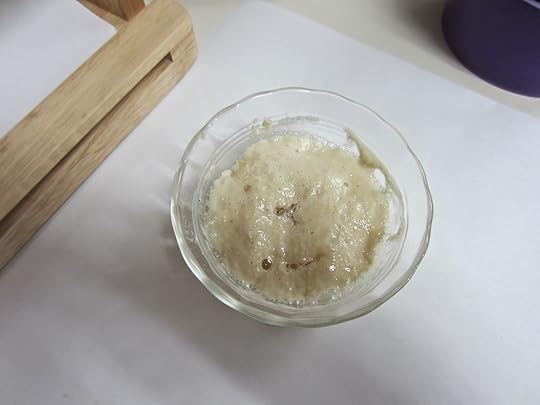
Thanks, y’all!
Enjoy
The post The Parable of the Leaven appeared first on beckyramsey.info.
June 28, 2021
The Parable of the Sower
 Welcome to the Parable of the Sower, from Matthew 13.
Welcome to the Parable of the Sower, from Matthew 13.
Jesus told this parable to answer the question, “What is the kingdom of heaven (God’s kingdom) like?” The wondering questions this week are really important, because they can help the children understand the meaning of the parable. I hope you’ll let the children struggle with each of so many questions. Sometimes it’s very tempting to give them your answer, but a little mind struggling will allow them to find an answer that they can own-instead of one they don’t really get, but feel you want them to believe. Even if they go down a wayward road, (we can always ask more questions to try to help them find their way) we will have “planted the seed” (how appropriate!) which they may discover later.
As you ask the wondering questions, if children have trouble, try to help them put themselves in the place of the sower. (Particularly helpful for questions 3,6,7,8,13,14)
So the important wondering questions we’ll use this week are:
1. I wonder if the person had a name.
2. I wonder who the person could really be?
3. I wonder if the person was happy when the birds came and ate the seeds.
4. I wonder if the birds were happy then they saw the sower.
5. I wonder who the birds really are.
6. I wonder what the person was doing when the little seeds could not get their roots in among the stones.
7. I wonder what the person was doing when the little seeds were choked by the thorns.
8. I wonder what the person was doing when the little seeds were growing in the good earth.
9. I wonder what the harvest could really be?
10. I wonder what the sower used for seed?
11. I wonder what the sower sold?
12. I wonder what the sower kept for food?
13. I wonder if the sower was surprised at the harvest?
14. I wonder what part surprised the sower most?
Idea Sparkers for our Create a Gift for God time:
This is the perfect time to actually sow some seeds. You could use Styrofoam cups or small terra cotta pots which the kids could decorate, then fill with soil in which to plant a seed. You could also have them write a verse on a Popsicle stick to put in the soil near the seeds they sow. They could choose a verse from the Bible story (a good way to have them look up the story themselves) or use Psalm 119:16b “I Shall not forget your Word.”
Children could also reproduce the parts of the parable box-the sower, the birds, the pots, the rocky ground, the thorns, the plants. Or, children could illustrate the parable with watercolors or markers or colored pencils.
For more art response ideas, check out my Pinterest page, here.
Enjoy!
The post The Parable of the Sower appeared first on beckyramsey.info.
June 22, 2021
The Parable of the Great Pearl
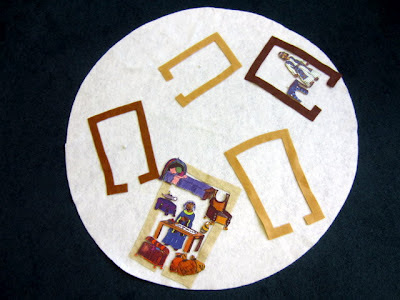 Welcome to our lesson for July 14, the Parable of the Great Pearl, based on the scripture found in Matthew 13:45-46.
Welcome to our lesson for July 14, the Parable of the Great Pearl, based on the scripture found in Matthew 13:45-46.
In a world like ours which places such importance on having things, this story gives us a chance to explore the greatest treasure one can possess: God’s kingdom and a relationship with God. What does it mean to sell all that we have to obtain this treasure? I bet the kids can help us figure this out.
The wondering questions are in the book. They include:
1. I wonder if the person was happy with the great pearl.
2. I wonder what the merchant is going to do now.
3. I wonder why the seller was willing to give up something so precious.
4. I wonder if the seller has a name.
5. I wonder if the merchant has a name.
6. I wonder what the great pearl could really be?
7. I wonder what could be so precious that a person would exchange everything for it?
8. I wonder if you have ever come close to the great pearl.
9. I wonder where this whole place could really be.
Thank you for having an adult take time to jot down the children’s responses to these questions.
Idea Sparkers for Our Give a Gift to God Time:
1. Make a “pearl” necklace. Hobby shops (Michaels, Hobby Lobby) has fake pearls that you can string. Each student could make themselves a necklace using one pearl and yarn, along with whatever other work they choose to do today.
2. What does the kingdom of God look like? What makes it such a priceless treasure?
Children could draw a mural together or individual pictures. What could they show people doing in the kingdom of God? Is nature in the kingdom of God? How are people treating nature and each other?
3. Children could make their own parable set, so they can retell this parable.
4. Make/buy a “pearl” snack to share. Maybe vanilla wafers to make the oyster shell and then frosting in between with a pearl of a dot of white frosting or a white jelly bean?
See more ideas on my Pinterest page, here.
Thanks, y’all!
Becky
The post The Parable of the Great Pearl appeared first on beckyramsey.info.
June 14, 2021
The Parable of the Good Samaritan
Welcome to our lesson for the Parable of the Good Samaritan.
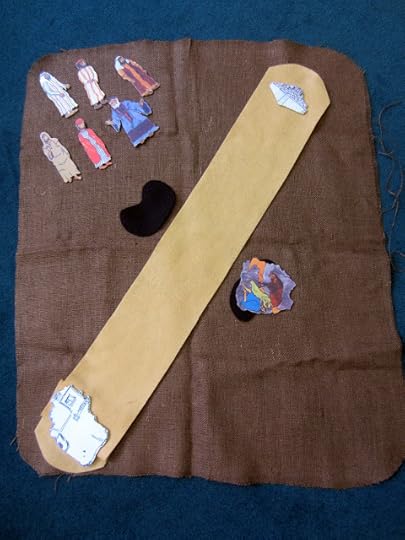
What a wonderful story about what it means to be a neighbor and our responsibilities as followers of The Way to help those around us. If you’re at FBC Greenville, you might want to include time in your morning to go visit the Good Samaritan statue near the remembrance garden.
Here are some wondering questions. Thank you for writing down their responses.
Wondering Questions:
1. I wonder who is the neighbor to the person who was hurt, had everything taken from him, and was left by the side of the road half dead?
2. I wonder what would happen if the person finding the injured traveler were a child?
3. I wonder what it means to be a neighbor.
4. I wonder if you’ve ever had anyone be a neighbor to you like this Samaritan was to the hurt man.
5. I wonder if you’ve ever been the one who was the Good Samaritan?
Idea Sparkers for our Gift to God Time
Here are some ideas for the parable itself:
1. Make get well cards as a way to help others, like the Good Samaritan in the story
2. Act out the story.
3. Make a collage or drawing on who is our neighbor.
4. Make a collage or drawing on How I Can Be a Good Samaritan.
5. You could also go with the What Would Jesus Do theme. Make a bracelet with WWJD, or a mural of the story, or act out scenes of different conflicts and ask the question, “What would Jesus do?”
6. If you’ve visited the Good Samaritan statue, why not ask the children if they’d like to try to make their own with play dough or quick dry clay?
See more art response ideas at my Pinterest Page, here.
Thanks for all you do!
The post The Parable of the Good Samaritan appeared first on beckyramsey.info.
June 8, 2021
The Parable of The Good Shepherd
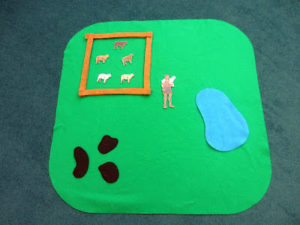 Welcome to the Parable of The Good Shepherd.
Welcome to the Parable of The Good Shepherd.
What a beautiful story that so perfectly depicts Jesus–the one who would (and did) lay down his life for his sheep! The parable is full of so much meaning, so many layers that the children can explore. I’m sure they’ll be ready to talk about their own times when they’ve “found the good grass” as well as times where they’ve felt that they (or others they know) have been through places of danger. It’s a great time to share our own such experiences and how our faith in God helped us make it through. Most every child has a story to share about being lost and found. I’m hoping you’ll enjoy lots of discussion with this lesson!
There are wondering questions within the story script for this lesson. I’ll have them in the classrooms for you to write in their responses.
Idea Sparkers for our Create a Gift for God time:
There are two ways to go here. The children can either reproduce the parable in some way, or they can explore their own experiences with what the parable talks about: being lost and found, their own faith in the Good Shepherd, their own times of good grass and cool water or times of danger and faith.
Ideas for reproducing the parable:
1. Let the children make their own miniature parable boxes with this week’s parable inside. If you want to buy small boxes, just purchase them, give me a receipt and I’ll reimburse you. We have green felt in the resource room. The kids could use fun foam for the pen and the water and the dangerous places, and could make the sheep however they want, with clothespins and cotton balls or their own ideas. Some links for sheep are here and here.
They could draw and cut out a wolf and the shepherd.
2. They could make their own sheep and shepherd puppets at the links above. (in #1)
Ideas for exploring the parable in terms of their own experiences:
1. The children could make a class mural/picture of how it feels to be lost (on one side) and found (on the other side). The title could be something like The Good Shepherd Takes Care of the Sheep or something like that.
2. They could illustrate My Good Shepherd Calls My Name, drawing the Good Shepherd and themselves.
3. This would be a perfect time to study and illustrate the 23rd Psalm!
Check out more art response ideas on my Pinterest page, here.
Enjoy!
The post The Parable of The Good Shepherd appeared first on beckyramsey.info.
June 1, 2021
Paul’s Discovery
 Welcome to the story of Paul’s Discovery.
Welcome to the story of Paul’s Discovery.
What a rich story of Saul/Paul, from birth to death! You’ll find the script in the yellow (Spring) book, p.126-135. The wondering questions are listed at the end.
Idea Sparkers for our Gift to God Time:
1. Paul’s life is so exciting. It would be fun to divide up the group and have the children act out scenes. Even our youngest kids could do it!
Scenes they may choose to act out:
1. Making tents with his father (bring a sheet from home and drape it over a table or rope) Pretend to hammer down stakes.
2. Waving goodbye to his family and traveling to Jerusalem (bring a suitcase)
3. Worshiping in the temple (Gather candlesticks, make a big scroll to read)
4. Saul trying to catch people who followed Jesus to bring them back for punishment.
5. Saul’s experience on the road to Damascus. (Maybe bring a lamp for a great light. )
Act out being led to Damascus and staying in the house, where the scales fall from his eyes.
6. Saul’s telling the good news of his transformation at the synagogue and then how Jesus’ followers hid him when people grew angry.
7.Paul’s escape over the city wall in a basket. (A laundry basket and rope would be perfect for this!)
8. Paul’s traveling and writing letters.
9. Paul kept as a prisoner in his own house.
2. Let the children work in pairs or alone to illustrate their favorite scene from the story. Have an “art show” at the end to look at everyone’s work and put the works in chronological order.
3. Examine the scrolls to see which books of the Bible do we think Paul wrote. Children could make bookmarks for their Bibles illustrated with scenes from Paul’s life.
For more art response ideas, check out my Pinterest page, here.
Enjoy, everyone!
The post Paul’s Discovery appeared first on beckyramsey.info.
May 24, 2021
Trinity Sunday
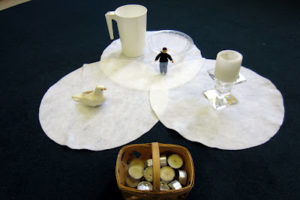 Welcome to our lesson for Trinity Sunday.
Welcome to our lesson for Trinity Sunday.
For this Sunday, we’ll use Lesson 6: Holy Baptism from the Winter (purple) book, p. 70-76.
The lesson is on baptism but it’s perfect for Trinity Sunday since a major component of the lesson is the Trinity. At the beginning of the script, it refers to “the Creator, the Redeemer, the Sustainer.” Do use those words, but add in an explanation of what they mean. Redeemer and Sustainer will be unfamiliar words to most children.
I would suggest that you modify the part of the script on baptism, fitting it to the way we do baptism in our church. Each of you should have in your classroom a bowl in which to pour the water, a pitcher, and a person (doll) to be baptized. I would encourage you to talk about the baptismal statement that baptismal candidates write (and a person special to them reads) expressing why they want to be baptized and what baptism means to them. I’ll have a copy of a baptismal statement that one of our children recently wrote in your rooms to share. (With permission, of course!) You might also talk about Discipleship Class, which our 4th and 5th graders can take in the fall and spring to learn more about baptism and being a disciple of Christ, before they are candidates for baptism.
The children would certainly enjoy the candle lighting part of the lesson. I hope you’ll feel brave enough. You might use tea candles (I’ll make sure there are plenty in your rooms.) For safety’s sake, you might have them sit on the carpet for this lesson and put the tea candle on the carpet in front of them, asking them to keep their hands in their laps at all times, assuring them that they will each have a chance to “change their own light.” I’ll make sure you have a candle snuffer in your room-so the children won’t blow out the candle, spattering wax on the carpet. If you choose to do this part of the lesson, I’m confident they will always remember it!
Here are some wondering questions for this lesson:
1. I wonder what was your favorite part of this lesson.
2. Today we heard more about the Trinity. We poured the water and talked about the water of creation. I wonder if God the Father is still creating today.
3. We also lit the big candle and talked about Jesus, the light of the world. I wonder how Jesus is a light. I wonder why we call him that.
4. We also remembered the Holy Spirit with the dove and the perfume. I wonder why we use perfume and a dove to remind us of the Holy Spirit.
5. I wonder what baptism means to you.
Idea Sparkers for your Gift to God time:
Focus on the Trinity
1. Your class could make a larger mural illustrating the three parts of the trinity, showing them intersecting like the circles of felt we used in the lesson. You could add illustrations to each circle. For God the Father, the children could draw creation in action, or their favorite old testament stories. For God the Son, the children could add drawings of their favorite Jesus stories, and for the Holy Spirit, the children could draw ways the Holy Spirit helps us–knowing right from wrong, giving us strength in times of trouble, helping us tell others about God, helping us understand the Bible, etc.
Each child could do this individually, but it could be more fun doing it together.
2. You could make simple trinity decorations, like this one from a blog with lots of great ideas,here. It’s simple, but the kids would enjoy making it. (Yey! A chance to use the glue gun!)
You can also glue on some symbols. This idea comes from this site.
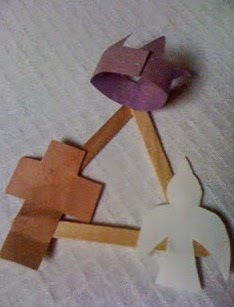
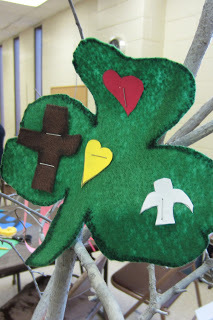 3. You could talk about how the shamrock or 3 leafed clover is often used to explain the trinity- one plant, with a leaf for each of the
3. You could talk about how the shamrock or 3 leafed clover is often used to explain the trinity- one plant, with a leaf for each of the 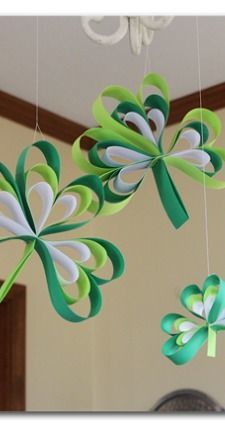 three parts. Then go clover hunting around the church. The children could pick a clover, bring it back, draw it big sized, and label each leaf with part of the trinity.
three parts. Then go clover hunting around the church. The children could pick a clover, bring it back, draw it big sized, and label each leaf with part of the trinity.
The fourth graders made something like this during our Easter lessons.
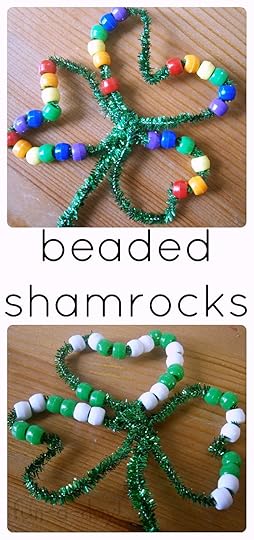 Found here.
Found here.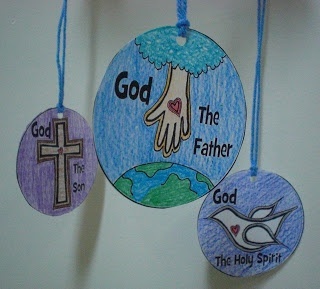 Found here.
Found here.Find some more art response ideas to get the kids started, go here to my Pinterest page.
Enjoy!
Love, Becky
The post Trinity Sunday appeared first on beckyramsey.info.
May 17, 2021
Knowing Jesus in a New Way 7: Known by the Holy Spirit
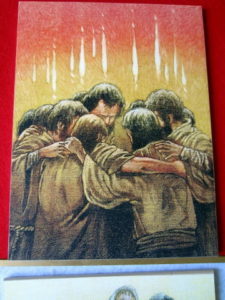 Welcome to Knowing Jesus in a New Way 7: Known by the Holy Spirit
Welcome to Knowing Jesus in a New Way 7: Known by the Holy Spirit
What a perfect time to not only share the story of the events of Acts 2:1-21, but to lead the children DURING the Godly Play lesson into an exploration of what the Holy Spirit is, what it did for the disciples and what it does for us today. A good time in the script to insert this is after you relay what Peter said, quoting Joel.
Here’s the part of the script as I would amend it:
(original script)
Peter stepped into this chaos with a confidence
and calm that the disciples had never seen before.
“These people are not drunk, like you think. After
all, it is only morning. What has happened is what
the prophet Joel wrote about. He said that God will
pour out God’s spirit on us so that our sons and
daughters will prophesy, the young will see visions,
and the old will dream dreams.
(Now, here’s the section you might add to help children get the concept of the Holy Spirit…)
The pouring out of God’s spirit was God’s gift of the
Holy Spirit. But was the Holy Spirit? Jesus had talked
about the Holy Spirit and when he did, he called it the
Comforter. He had told the disciples that it would come
after He left them. And now it was here! But what would
it do? Jesus had talked about that too and we can find it in the
book of John. Jesus had said that the Holy Spirit …
1. helps people see what they’ve done wrong and points
them to God
2. helps people do what is right
3. helps us understand the Bible
4. prays for us-the Bible says that He prays to God when
we sometimes don’t know how or what to pray. Helps us
through our hard times
5. helps us find out what our special gifts are so we can use
them to help others
The Holy Spirit had come! It had happened!
(The original script picks back up here…)
Many passed on by to keep their great traditions and live
good lives. Others listened and became baptized…..
(Continue with rest of the script.)
You can see that I’ve included questions about the Holy Spirit in my wondering questions.
Wondering Questions
1. I wonder what is your favorite part of this story.
2. I wonder what the disciples thought was happening when the mighty wind filled the house and bits of fire began to dance around each person.
3. I wonder how it felt to have God’s spirit poured out on you.
4. I wonder what you would have thought if you were on the streets when the disciples ran out, overjoyed, telling everyone what happened in different languages.
5. Before Pentecost the disciples felt the love from Jesus. At Pentecost the holy spirit helped the disciples feel the love inside them. I wonder how the love helped the disciples do their work.
6. I wonder how the holy spirit can help you.
7. When we celebrate Pentecost, we call it the day the church was born-it’s birthday. I wonder why that might be.
I really hope that if you’re in a room where the children have access to Godly Play materials, that after the story is shared, you’ll try letting the children select something to bring to the circle that helps tell the story. Those connections can be so meaningful.
IDEA SPARKERS FOR OUR GIFT TO GOD TIME
1. Flame hats or headbands
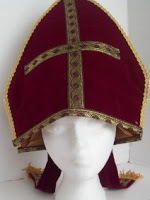
In some Christian churches church officials wear flame shaped hats to remind us of the flames seen over Christ’s followers on the day of the first 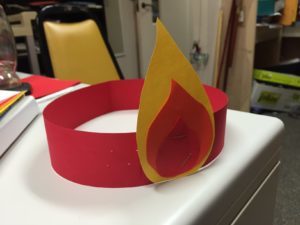 Pentecost.
Pentecost.
Why not show a picture of such a hat and let the kids design how they want to do their own. It doesn’t have to look like that one. Have fun foam or cardboard or fabric on hand- and long strips of large construction paper for the band part.
2. Flame portrait
As followers of Christ, let each child draw themselves as a disciple, with flames at the top of their heads. These flames could be added with tissue paper or paint or whatever they choose.
3. Make pinwheels or kites or windsocks to remind us of the mighty wind that filled the house.
There are great instructions for making a pinwheel here. If the kids want to make a kite, you can find instructions for making a real working one here, or just cut a kite shape out of paper and kids can decorate it as they want, hopefully with the story of Pentecost in mind.
Or make a Pentecost windsock, as shown here.
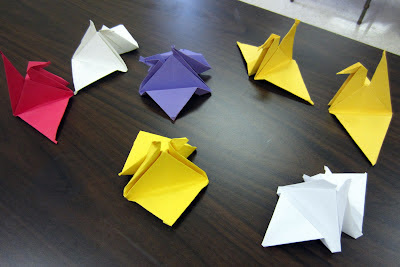
4. Doves
Since the symbol of the holy spirit is the dove, why not make flame colored doves (yellow, orange, red) and hang them from the ceiling to remind us of Pentecost. There are directions for doves here. Or make an origami one as shown in the video below.
5. Birthday Cake-Since we celebrate the birthday of the church as we remember Pentecost, you could bring plain cupcakes to Sunday school and allow time for the kids to frost them and decorate them. If you’re feeling brave, you could have each child light a candle for their cupcake and remember the gift of the spirit, which looked like flames above each follower’s head.
See more art response ideas at my Pinterest page, here.
Enjoy the story!
Love, Becky
The post Knowing Jesus in a New Way 7: Known by the Holy Spirit appeared first on beckyramsey.info.
May 10, 2021
Knowing Jesus in a New Way 6: Known in Waiting
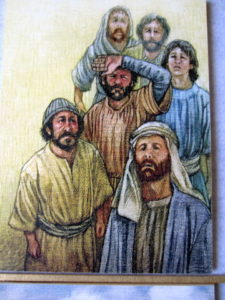 Welcome to Knowing Jesus in a New Way 6: Known in Waiting.
Welcome to Knowing Jesus in a New Way 6: Known in Waiting.
What a wonderful opportunity to again talk about the disciples’ experience with having Jesus right beside them and then having to learn to live with him in a completely different way. The children have not witnessed this event of course, but most know what it feels like to be left or abandoned-even temporarily-by someone they love- or to feel afraid of what that might be like. For modern Christians whom have never had the joy of having Jesus physically with us, it takes some thinking to imagine what that must have been like, and then to have it taken away.
In addition to discussing the story itself, this Sunday is a good time to talk about the idea that feelings are not always the truth of what is really happening. When bad things happen we may feel abandoned by God, but that is not the truth. God never abandons. So what do we do when we have these feelings and fears? What did the disciples do? They did what Jesus told them to do.They waited and prayed and obeyed Jesus’ commands until they would be with Jesus again in heaven. As in the sermon last Sunday, they did the ordinary things of living as they waited on God. They chose a replacement for Judas. They went on with life, holding onto each other and to prayer.
I hope that if you’re in a room where the children have access to Godly Play materials, that after the story is shared, you’ll try letting the children select something to bring to the circle that helps tell the story. Those connections can be so meaningful.
Here are the wondering questions for Sunday.
1. I wonder what is your favorite part of today’s story.
2. I wonder if you’ve ever been left behind. I wonder how that feels.
3. Before Jesus disappeared he told the disciples that they would be baptized in the Holy Spirit. I wonder what they thought would happen. I wonder what they thought the Holy Spirit was. I wonder what you think the Holy Spirit is.
4. When Jesus vanished, I wonder if he was really gone. I wonder how he was still with the disciples.
5. I wonder where you are in this story. I wonder what part of this story is about you?
Ideas for Our Gift to God Time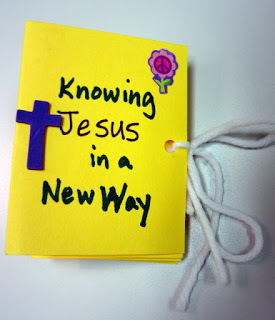 1.Today would be a great time for children to put all the Eastertide stories together in one project. They could do this as a class with a mural, with pairs of children working on a single story of this series, or they could put it together in a little booklet like the one below.
1.Today would be a great time for children to put all the Eastertide stories together in one project. They could do this as a class with a mural, with pairs of children working on a single story of this series, or they could put it together in a little booklet like the one below.
For the example I made here I took 12″ x18″ pieces of construction paper from the paper closet, cut each of them into 3 long strips of 4″x 18″ and folded each accordion-style into 6 sections.
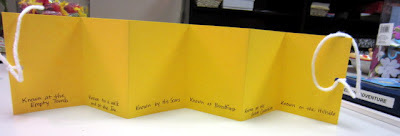
I went ahead and labeled each section with the story title: Known at the empty tomb, Known on a walk and at the inn, Known by his scars, Known at Breakfast, Known at the Great Commission, and Known on the hillside. You could also add where each scripture is found in the Bible. Then children can illustrate each block.
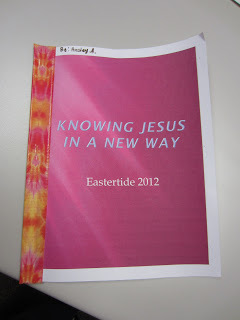
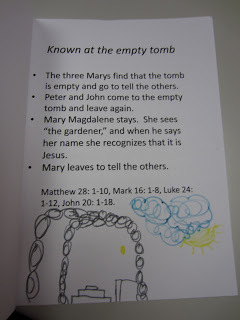
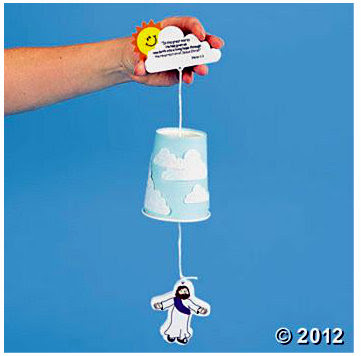 2. Another idea is to celebrate the ascension story on its own by making your own Ascending Jesus, as shown in this kit from Oriental Trading.
2. Another idea is to celebrate the ascension story on its own by making your own Ascending Jesus, as shown in this kit from Oriental Trading.
You don’t need a kit to make this- just a solo cup and string and paper. It would be much more meaningful for the children to make it their own way, drawing their own Jesus and constructing it as they want, like the children here have done. (Scroll down and see below.)
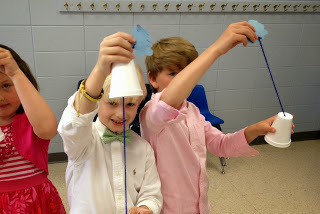
3. Why not show the children images that artists have created showing the ascension and ask them to do their own watercolors or drawings of how they think it might have happened? It’s a mystery, so it would be interesting to see how they picture it. Find artwork to share with the children on my Pinterest page of ascension artwork here.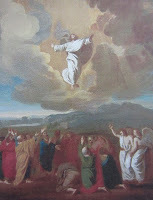
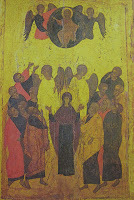
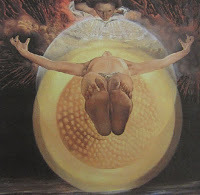
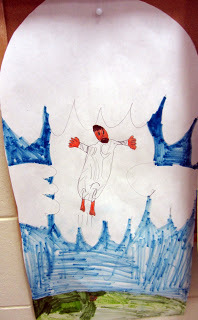
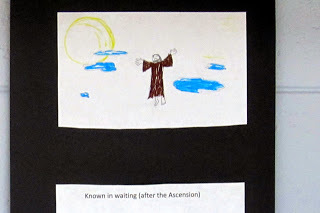
See some more art response ideas on my Pinterest page, here.
Enjoy the story!
Love, Becky
The post Knowing Jesus in a New Way 6: Known in Waiting appeared first on beckyramsey.info.

